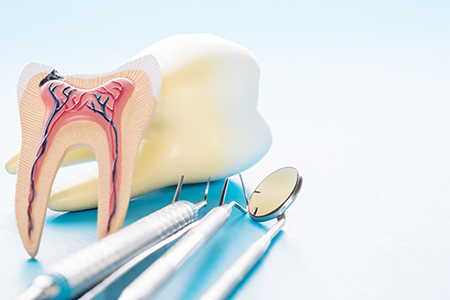
Our Office
Visit Us Online

If a dental professional recommends a root canal, it’s not a reason to panic. Modern root canal therapy is a common, carefully controlled procedure designed to relieve pain, remove infection, and save natural teeth. In many cases, choosing treatment preserves chewing function, supports neighboring teeth, and avoids the long-term consequences that can come with tooth loss.
At the office of Frankford Dental Group, we combine up-to-date clinical techniques with attention to comfort so patients can expect precise care delivered with empathy. Our goal is to preserve your natural smile whenever possible while keeping you informed and comfortable at every step.
Keeping a healthy, natural tooth is typically the best outcome for both function and appearance. Root canal therapy removes diseased or damaged pulp tissue from inside a tooth and seals the space to prevent reinfection. When a tooth can be preserved instead of extracted, it helps maintain proper bite alignment and reduces stress on adjacent teeth.
Success rates for contemporary root canal procedures are high, largely because of improved techniques, materials, and diagnostic imaging. Endodontic instruments, biocompatible filling materials, and careful isolation of the treatment area all contribute to predictable results. Most patients are surprised by how routine and manageable the process can be.
Choosing root canal therapy when appropriate is not only about immediate relief; it’s an investment in long-term oral health. A well-treated tooth can remain functional for many years, often for the rest of a patient’s life, when followed by an appropriate restoration and regular maintenance.

Each tooth contains a central chamber that houses the dental pulp—a network of connective tissue, blood vessels, and sensory nerves. This pulp helps a tooth develop and provides nutrients while the tooth is maturing. After a tooth is fully formed, it can remain healthy without an active pulp, which is why root canal therapy is a viable option when the pulp becomes compromised.
Damage to the pulp can come from deep decay, a traumatic injury, repeated dental procedures, or cracks that allow bacteria to enter. As the pulp becomes inflamed or dies, symptoms may range from mild sensitivity to intense, persistent pain. The precise presentation varies by case, so clinical and radiographic evaluation is key to determining the appropriate treatment.
Not every toothache or sensitivity requires a root canal, but certain signs point strongly toward the need for intervention. Early diagnosis and treatment improve the likelihood of saving the tooth and preventing spread of infection to surrounding bone and tissues.
Below are several common warning signs that should prompt an evaluation by a dental professional:
Pain that persists, intensifies, or wakes you from sleep is a classic indication that the internal tissues may be compromised. While not every persistent ache equals pulp damage, this symptom merits prompt attention.
If hot or cold foods trigger sharp or lingering pain, the nerve inside the tooth may be inflamed. Over-the-counter sensitivity remedies help in some cases, but a lasting reaction should be evaluated.
Discomfort with pressure—especially when chewing—can indicate that the pulp or surrounding structures are affected. This symptom often points to infection or structural damage within the tooth.
A tooth that becomes discolored after an injury or over time may have lost vitality. Internal staining often signals that the pulp has been damaged or has died.
Trauma that fractures tooth structure can expose or injure the pulp. Even a small crack can allow bacteria to penetrate and lead to inflammation or infection.
Swelling near a tooth, a tender lump on the gum, or an area that drains fluid are signs that an infection may be present at or near the root. These findings require timely care to prevent progression.
Advanced infection can affect the bone that supports a tooth, causing mobility. Treating the source of infection often allows healing and stabilization of the affected area.

Prompt evaluation is important because infections and inflammation can progress silently. Some teeth show no overt pain while significant damage develops; in other cases, symptoms can escalate quickly. A delay in care increases the chance that a tooth will require more extensive treatment or, in some situations, extraction.
Beyond the local effects, an untreated dental infection can impact adjacent teeth and surrounding bone. In rare circumstances, oral infections can have broader health implications, particularly for patients with certain medical conditions. That’s why timely diagnosis and management are central to preserving health and function.
Regular dental exams and radiographs help catch problems early—often before severe symptoms arise. When a clinician recommends root canal therapy based on clinical findings and imaging, following through with treatment improves outcomes and reduces the risk of future complications.
Contemporary root canal procedures focus on removing infected tissue, shaping and disinfecting the canal system, and sealing the space to prevent reinfection. Most treatments are performed under local anesthesia, making them comfortable for the majority of patients. For those with anxiety or special needs, additional sedation options are available to increase comfort and reduce stress.
The number of visits and the length of each appointment depend on the tooth’s anatomy and clinical condition. Some cases are completed in a single visit; others require multiple appointments when infection control or canal anatomy demands staged care. During treatment, the dental team uses magnification, precision instruments, and irrigants to thoroughly clean the canals.
After the canals are filled with a biocompatible material and sealed, the tooth needs a restoration that restores strength and function. Often this means placement of a permanent crown or other durable restoration to protect the tooth from fracture and to restore the biting surface.

Recovery is typically straightforward. Immediately after the procedure you may experience numbness from local anesthetic and mild soreness as the tissues settle. These effects usually subside over a few hours to several days. Our team will provide guidance on pain management strategies and any medications that may be helpful.
It’s important to protect the treated tooth until the final restoration is placed. Temporary fillings are effective for short-term protection, but the tooth remains more vulnerable to fracture until it is fully restored. Avoiding hard or sticky foods on the treated side helps prevent complications while healing occurs.
Long-term success depends on appropriate restoration and good oral hygiene. Regular dental checkups and professional cleanings support healing and allow early detection of any changes. With the right follow-up care, teeth that have undergone root canal therapy can function reliably for many years.
Aftercare considerations you should keep in mind include:
Anesthesia can leave lips and cheeks feeling numb for a short time. Be cautious while eating or doing activities that could result in accidental biting or injury until normal sensation returns.
Mild to moderate soreness is common and usually resolves within a few days. Over-the-counter pain relievers and rest are often sufficient; if more significant discomfort occurs, contact your dental team for guidance.
If antibiotics are recommended to address or prevent infection, take them exactly as directed and finish the course. This helps ensure complete resolution of infection and supports healing.
A temporary filling or restoration is not designed for long-term chewing stress. Try to chew on the opposite side and avoid biting directly on the treated tooth until your permanent restoration is placed.
Continue brushing and flossing the treated area gently. Good home care reduces the risk of new problems and supports the long-term health of the restored tooth.
Discuss the best final restoration with your dentist and schedule it in a timely manner. A crown or other appropriate restorative option will return strength and function to the tooth and minimize the risk of future breakage.
With careful treatment and routine care, a tooth treated with root canal therapy can remain a dependable part of your smile for years to come. If you have questions about symptoms, the procedure, or recovery, the team at Frankford Dental Group is available to explain your options and help you make an informed decision.
A root canal procedure is the best way to save a tooth that has been damaged by decay or injury and preserve your natural smile. The alternative is an extraction and treatment to replace the tooth. While at times a tooth is non-restorable and an extraction is the only option, when possible, it’s best to try and save your natural tooth. With proper care, a tooth with root canal therapy can serve your smile well for many years to come.
Despite lingering myths from before the age of modern dental anesthesia and technology, having a root canal procedure today is as routine and comfortable as visiting the dentist for a filling. While the procedure is performed under local anesthesia with your tooth completely numbed, we can also discuss options in dental sedation.
Whether the symptoms of a dental infection subside after a course of antibiotics, a draining abscess provides you with some temporary pain relief, or a tooth with radiographic evidence of pathology has not yet developed symptoms, it’s essential, before an infection worsens or occurs, to have a root canal procedure performed. In this way, the tooth can be disinfected, filled, and sealed to protect your health and avoid further problems.
If you have sustained a dental injury, have a toothache, jaw pain, swelling, or are experiencing any other unusual and uncomfortable oral symptoms, contact our office immediately for care. Dental problems that have not been evaluated and treated can significantly worsen, producing more severe damage and consequences for the involved teeth, your oral health, and even your overall wellbeing. Once you get in touch with our office, our friendly and compassionate office team will get you in for care at your earliest convenience.
While some root canal procedures can be completed in one visit, others may involve 2 or 3 appointments. How long it takes depends on various factors, including active infection, the number of canals in the tooth, and the tooth’s location or anatomy.
With a success rate that exceeds 95%, root canal therapy remains the most effective procedure to save a tooth in which the inner vital tissues have been damaged. However, as with all healthcare procedures, there are a small percentage of cases where the teeth become symptomatic a second time. The good news is that many of these teeth can still be saved with root canal retreatment or a minor surgical procedure known as an apicoectomy.
The best ways to maintain a tooth with root canal therapy are to get the proper restoration required to rebuild and protect the tooth, maintain proper oral hygiene, and schedule appointments for routine dental checkups and care.
Saving a tooth with root canal therapy is a wise investment that, in the long run, is typically less costly and invasive than having the tooth extracted and replaced with a fixed bridge or implant. As far as the exact cost of care, it can vary depending on which tooth is being treated. Many dental insurance plans provide coverage for root canal therapy. At the office of Frankford Dental Group, we do our best to optimize your dental benefits and minimize your out-of-pocket expenses. Our staff will answer all your questions about the cost of care and discuss all your payment options.
At the office of Frankford Dental Group, we use the latest technology and most effective methods of care to provide precise and gentle care. Our reputation for excellence is based upon a consistent record of achieving successful treatment outcomes while providing prompt, stress-free, and convenient treatment for every type of dental need.
A root canal is a dental procedure that removes infected or damaged pulp from the interior of a tooth, cleans and disinfects the canal system, and seals the space to prevent reinfection. The primary goals are to relieve pain, eliminate infection, and preserve the natural tooth rather than remove it. Saving a tooth maintains chewing function and helps protect adjacent teeth from extra stress.
Modern root canal therapy uses precise instruments, effective disinfectants, and biocompatible filling materials, which contribute to predictable outcomes. When combined with an appropriate final restoration, a treated tooth can often function for many years. Early diagnosis and treatment improve the likelihood of long-term success.
Several symptoms commonly indicate that the tooth's pulp may be compromised, including persistent or worsening toothache, sharp reactions to hot or cold that linger, and pain when biting or tapping the tooth. Other warning signs include a tooth that darkens in color, visible cracks or chips, swollen gums, or a draining spot on the gum near the affected tooth. Symptoms can vary, and some infected teeth produce minimal or no pain while significant damage progresses.
Because signs are not always obvious, regular dental exams and timely radiographs help catch problems early before more extensive damage occurs. If you experience any of the symptoms above, prompt evaluation reduces the risk of spread of infection and increases the chance of preserving the tooth. Your dentist can explain findings and recommend the best treatment based on clinical and imaging results.
Diagnosis begins with a thorough clinical exam, discussion of symptoms, and targeted tests such as percussion, thermal sensitivity, and mobility checks to assess the health of the pulp and surrounding tissues. Dental X-rays or cone beam imaging are commonly used to visualize the extent of decay, bone involvement, and root anatomy, which helps confirm whether the pulp is inflamed or infected. These diagnostic steps together provide the information needed to recommend root canal therapy when appropriate.
Sometimes additional factors such as previous restorations, cracks, or trauma influence the decision. In certain cases, clinicians may monitor a tooth conservatively before proceeding, but clear signs of irreversible pulpitis or abscess generally prompt timely treatment. Your dentist will review the findings and discuss the rationale for any recommended procedure.
Most root canal procedures are performed under local anesthesia to ensure patient comfort while the dentist accesses the pulp chamber, removes diseased tissue, and cleans and shapes the canal system using specialized instruments and irrigants. The canals are then filled with a biocompatible material and sealed to prevent bacterial reentry, with care taken to manage complex anatomy and maintain a sterile field. Depending on the tooth and clinical situation, treatment may be completed in a single visit or staged across multiple appointments to control infection and achieve optimal cleaning.
The office of Frankford Dental Group uses magnification and modern materials to enhance precision and reduce the risk of postoperative complications. Once the root canal portion is finished, the tooth typically receives a permanent restoration such as a crown to restore strength and function. Your dental team will explain each step and tailor the approach to the condition of your tooth.
With contemporary techniques and local anesthesia, most patients report minimal discomfort during the procedure, as the anesthetic blocks sensation in the treated area. Some soreness or mild inflammation is common after treatment and usually responds well to over-the-counter pain medications and short-term rest. The expectation of pain is often greater than the actual experience thanks to improved analgesia and careful clinical technique.
For patients with dental anxiety or those requiring more extensive work, additional sedation options may be available to enhance comfort and reduce stress. Discuss your medical history and comfort preferences with the dental team so they can recommend appropriate measures, which may include nitrous oxide or other sedation choices when indicated. Clear communication before the visit helps ensure a controlled, comfortable experience.
The number of visits depends on the tooth's anatomy, the presence of infection, and the chosen treatment plan; many straightforward root canals are completed in a single appointment, while more complex cases or those with active infection may require two or more visits. Each appointment typically ranges from about 60 to 90 minutes, though molars with multiple canals can take longer due to the need for thorough cleaning and shaping. Scheduling considerations are discussed in advance so patients understand the time commitment.
When multiple visits are necessary, temporary restorations protect the tooth between appointments while infection control is achieved and healing progresses. The dental team will provide an estimated timeline tailored to your case and coordinate the placement of the permanent restoration once the canals are fully treated. Efficient planning helps minimize disruption while ensuring clinical success.
Recovery is generally straightforward; you may experience numbness from local anesthesia for a few hours and mild soreness for several days as tissues calm down. Managing discomfort with recommended analgesics, applying cold packs for swelling if advised, and resting for the remainder of the day help the healing process. If you notice severe pain, swelling that worsens, or other concerning signs, contact the dental office promptly for guidance.
Protect the treated tooth until the permanent restoration is placed by avoiding hard or sticky foods on that side and following any temporary-filling instructions. Maintain gentle but thorough oral hygiene to keep the surrounding gums healthy and attend scheduled follow-up appointments so the clinician can confirm healing and proceed with the final restoration. Frankford Dental Group can answer specific recovery questions and schedule necessary follow-up care.
After root canal therapy a tooth can be more brittle because much of the inner tissue has been removed and older restorations or decay may have weakened the structure, so a protective restoration is important to prevent fracture and restore function. Crowns are commonly recommended for posterior teeth since they cover the entire biting surface and distribute chewing forces evenly, reducing the risk of future breakage. For front teeth or cases with minimal structural loss, other restorations such as bonded buildups or onlays may be appropriate.
Your dentist will evaluate remaining tooth structure, bite dynamics, and aesthetic needs to recommend the best restorative option. Timely placement of the permanent restoration is a key factor in long-term success and helps maintain the seal achieved by the root canal. Discuss material choices and the expected timeline with your dental team to ensure the selected restoration meets functional and cosmetic goals.
Delaying necessary root canal therapy increases the likelihood that infection and inflammation will worsen, potentially leading to abscess formation, bone loss around the tooth, and spread of infection to adjacent teeth or tissues. As damage progresses, the tooth may become more difficult to save and could ultimately require extraction, which then necessitates replacement options that affect surrounding teeth and jaw health. Early treatment reduces these risks and generally leads to simpler, more predictable outcomes.
In some cases a tooth with minimal symptoms may appear stable while underlying pathology advances, so routine dental exams and imaging are important for timely detection. If a clinician recommends root canal therapy based on diagnostic findings, following through with treatment when advised improves the chance of preserving the natural tooth and avoiding more extensive procedures later. Prompt care supports both oral health and overall well-being.
Contemporary root canal treatments have high success rates, often allowing teeth to remain functional for many years when properly restored and maintained. Factors that influence longevity include the quality of the root canal filling, the type and timing of the final restoration, the tooth's structural condition, and the patient's oral hygiene and overall health. Regular dental checkups and prompt attention to any new symptoms help preserve the restored tooth.
In many cases a well-treated and well-restored tooth can last a lifetime, though retreatment or additional procedures may be needed in a minority of cases if new infection or structural problems occur. Your dentist will monitor the tooth during routine visits and recommend appropriate care to maximize durability. With proper treatment and follow-up, root canal therapy is a reliable way to keep your natural tooth in service.
Available after hours by appointment.
